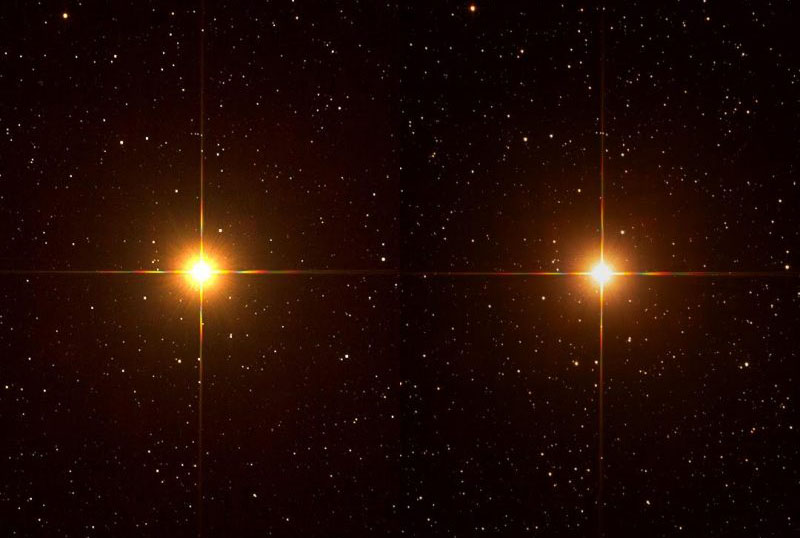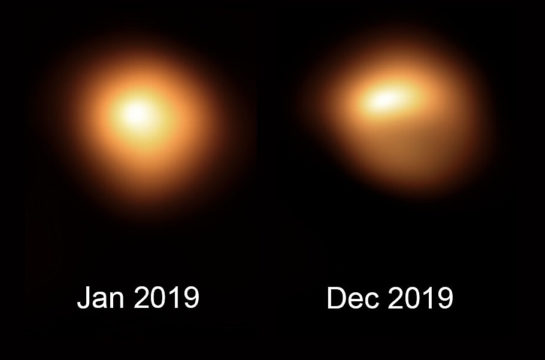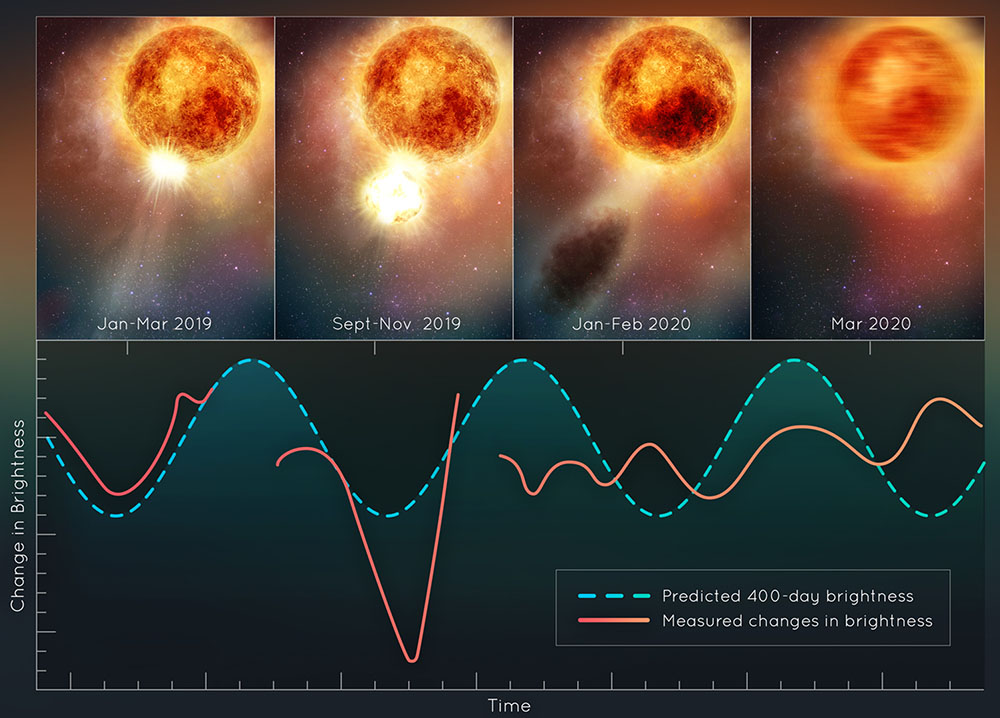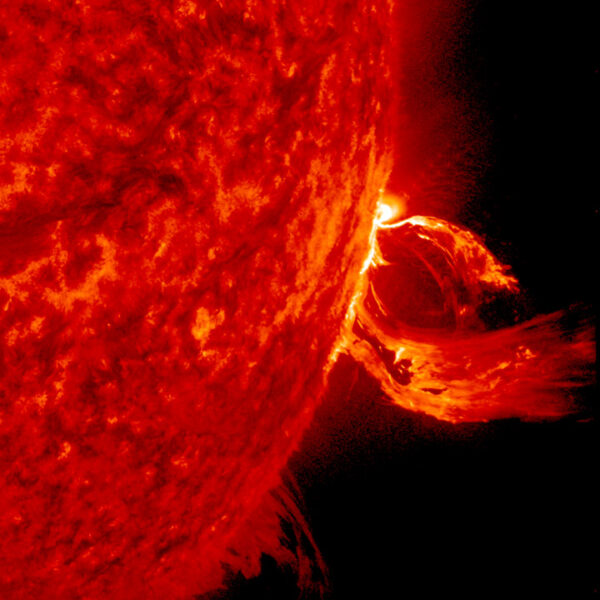The Great Dimming occurred when Betelgeuse coughed out a huge chunk of material, and the ejection took a toll on the giant star.

Courtesy of Brian Ottum and EarthSky
An international team of astronomers has revealed why the star Betelgeuse famously dimmed back in 2019. The dying star coughed out a huge chunk of material weighing several times more the Moon, which then blocked out some of its light.
Betelgeuse is the 10th brightest star in the night sky and marks Orion's right shoulder (his left shoulder from our point of view). It is a red supergiant, an engorged monster that would stretch out to the orbit of Jupiter if it replaced the Sun in our solar system. Betelgeuse is well on its way to ending its life by detonating as a cataclysmic supernova; meanwhile, astronomers get unprecedented insight into a giant star’s final stages.
The situation became more intriguing in late 2019 when Betelgeuse mysteriously dropped in brightness, an event that came to be known as The Great Dimming. The fading was pronounced enough, more than a magnitude, to notice even with the unaided eye. Lots of possible explanations have been mooted, but now a team led by Andrea Dupree (Center for Astrophysics, Harvard & Smithsonian) thinks they know what happened.

ESO / M. Montargès et al.
By piecing together data from a slew of telescopes, including the Hubble Space Telescope, Dupree is pointing the finger at an event called a Surface Mass Ejection (SME). Our own Sun regularly burps material from its corona, ejecting a billion tonnes of solar material — about the mass of Mount Everest. But Betelgeuse’s SME spit out 400 billion times more material, equivalent to several times more mass than the Moon. As the ejected material cooled, it formed a cloud of dust that partially blocked, and thus dimmed, our view of Betelgeuse.

NASA / ESA / Elizabeth Wheatley (STScI)
"We've never before seen a huge mass ejection of the surface of a star,” Dupree says. “We are left with something going on that we don't completely understand.”
The likely cause of the upheaval was a giant plume inside the star that measured a million miles across — four times the distance between Earth and the Moon. It bubbled up to the surface, causing shocks and pulsations that threw material into space. Betelgeuse’s bloated size made the effects more pronounced; its surface gravity is 10,000 times weaker than the Sun’s.

NASA
The event seems to have had a profound effect on Betelgeuse’s more regular pulsations. Astronomers have observed the star for centuries and noticed that it goes through cycles of brightness variations with a period of 400 days. This pattern seems to have completely disappeared since The Great Dimming, perhaps as result of a reshuffling of material in the star's interior. “Betelgeuse continues doing some very unusual things right now,” Dupree says.
“These observations allow us to watch . . . as a giant star re-adjusts and settles down after a huge disturbance,” says Thomas Baumgarte (Bowdoin College), who was not involved in the research. “This is truly a unique opportunity, with lots of potential to advance our understanding of these stars.”
Emily Cannon (KU Leuven, Belgium), also not involved in the work, says the process must be put into context. “Red supergiants exhibit powerful mass loss, expelling the entire mass of our Sun into the interstellar environment over a timespan of 10,000 to 1 million years,” she says. “While still contributing to the overall mass loss, this single event ejecting approximately 0.000001 solar masses is not a lot for these type of stars.”
We have never witnessed an event like this before, but that doesn't mean it’s uncommon. After all, as Dupree says, we're now “watching stellar evolution in real-time.”
 6
6









Comments
misha17
August 25, 2022 at 2:57 pm
It was pretty unsettling to see Orion with its shoulder dimmed. I have to admit I was pretty relieved when it started to recover.
It was a good "warning" of what to expect after Betelgeuse finally does bow out. Here in Soutern California the light pollution is so bad, another magnitude or two of dimming would have made it all but invisible as seen from cities.
You must be logged in to post a comment.
Genac
August 29, 2022 at 9:49 am
I visited LA a few years back and was astounded at how dark its sky was, although a poodle could have leapt the bar of my expectation. The town of 6,000 where I grew up in the hills of Penna is brighter; they replaced their street lights with those that might as well point up. I live in Baltimore and sky visibility here is avoidably poor. LA must be trying at least.
You must be logged in to post a comment.
Lindsay
August 26, 2022 at 7:20 pm
The asteroid of 66 million years ago that killed the dinosaurs was about the size of Mt Everest. You say our Sun 'regularly burps' an SME that size? What would happen on Earth if a SME of this size were directed directly at Earth?
You must be logged in to post a comment.
misha17
August 27, 2022 at 3:18 pm
The asteroid was a solid body and its mass impacted the earth pretty much instantaneously.
The mass in an SME consists of plasma and is spread out over a large volume, like a bubble, and that bubble continues to expand as it moves away from the sun. By the time it crosses the Earth's orbit, the Earth only encounters a small part of it, and not all at once - when the Earth encounters an SME it triggers aurorae for about a day as it passes through the SME "bubble".
Rough analogy: If you get hit by a hard-thrown snowball, it can know you off your feet, but if you walk for an hour while snow is falling, even when the wind is blowing, the same amount of snow probably falls on you (if not more), but not all at once so you can dust it off as you keep walking. If you do topple over, it's from the force of the wind, not the mass of the blowing snow.
You must be logged in to post a comment.
misha17
August 27, 2022 at 3:19 pm
in the first line of the 2nd paragraph, "know" shoudd be "knock"
You must be logged in to post a comment.
Genac
August 29, 2022 at 9:51 am
"Maybe a comet killed the dinosaurs, maybe they tripped and fell. We don't know who shot Kennedy and we have FILMS of that".
-- Seinfeld
You must be logged in to post a comment.
You must be logged in to post a comment.